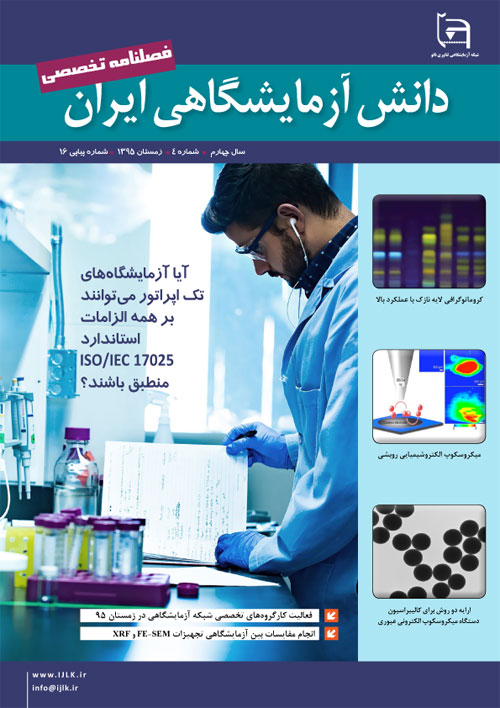فهرست مطالب

مجله دانش آزمایشگاهی ایران
سال چهارم شماره 4 (پیاپی 16، زمستان 1395)
- تاریخ انتشار: 1395/12/15
- تعداد عناوین: 7
- اخبار
-
صفحه 4
- مقالات
-
صفحه 35
-
Page 5
High performance Thin-layer chromatography, thin layer chromatography improved form which is automatically done with chromatographic steps increases the separation and measurement of quality and quantity with a higher accuracy.This is not another alternative chromatographic methods.Compared with other chromatographic techniques, time and cost analysis with this method is very low And the unique capabilities of the stake is in place.
Keywords: Chromatography, Thin Layer Chromatography, High Performance Thin LayerChromatography, Mass Spectrometry -
Page 15
Advances in nanotechnology over the past decade have made scanning electron microscopy (SEM) an indispensable and powerful tool for analyzing and constructing new nanomaterials. Many efforts have been made to attain higher quality images and to facilitate the work done by the scanning electron microscope. One of the measures taken to change and correct is relevant to the source of electrons as known as the filament. The filament has various types which using each of them depends on the expected results. This article is an attempt to become more familiar with the different types of filament used in the scanning electron microscope and then comparison and also applications will be discussed.
Keywords: Nanotechnology, Scanning electron Microscope, Filament -
Page 19
Scanning electrochemical microscopy (SECM) is a scanning probe microscopy, electrochemical theory is advanced and accurate based on the information obtained from the nature of the variation of the tip, and the interplay of the tip is attached to the substrate. SECM is a powerful tool for studying structures and processes in micrometer- and submicrometer-sized systems.It can probe electron, ion, and molecule transfers, and other reactions at solid-liquid, liquid–liquid, and liquid-air interfaces.10 This versatility allows for the investigation of a wide variety of processes, from metal corrosion to adsorption to metabolism in single living cells.
Keywords: Scanning electrochemical microscopy, Ultramicroelectrode, Feedback mode -
Page 30
ISO/IEC 17025:2005 states that its requirements are “applicable to all laboratories regardless of the number of personnel” and would therefore include single-operator laboratories. However, there are reservations as to whether these laboratories can comply with all of the requirements without jeopardizing independence of judgement and impartiality. Similarly, there are some requirements of ISO/IEC 17025:2005 including staff supervision, internal communication processes and appointment of deputies that are considered unlikely to apply to a singleoperator laboratory. The ISO/IEC 17025:2005 is widely used as the international standard of quality assurance by which accreditation bodies assess the competency of testing and calibration laboratories. There does, however, appear to exist, disagreement amongst accreditation experts when considering single-operator laboratories. Some accreditation bodies accredit single-operator laboratories, whilst others require additional human resources prior to granting accreditation. This discrepancy leads to unfair competition amongst laboratories as a singleoperator laboratory by definition needs less resources (both human and financial) to achieve and maintain accreditation, compared with a laboratory where additional human resources need to be sought prior to and in order to maintain accreditation. The ISO/IEC 17025:2005 is in the process of being revised, and this is an opportune moment to address the issues aforementioned with the aim of removing ambiguity and enhancing clarity. In addition, the hope is to assist the accreditation bodies themselves to adopt a consensus approach when granting accreditation towards single-operator laboratory.
Keywords: ISO, IEC 17025, Accredited, single-operator laboratories


